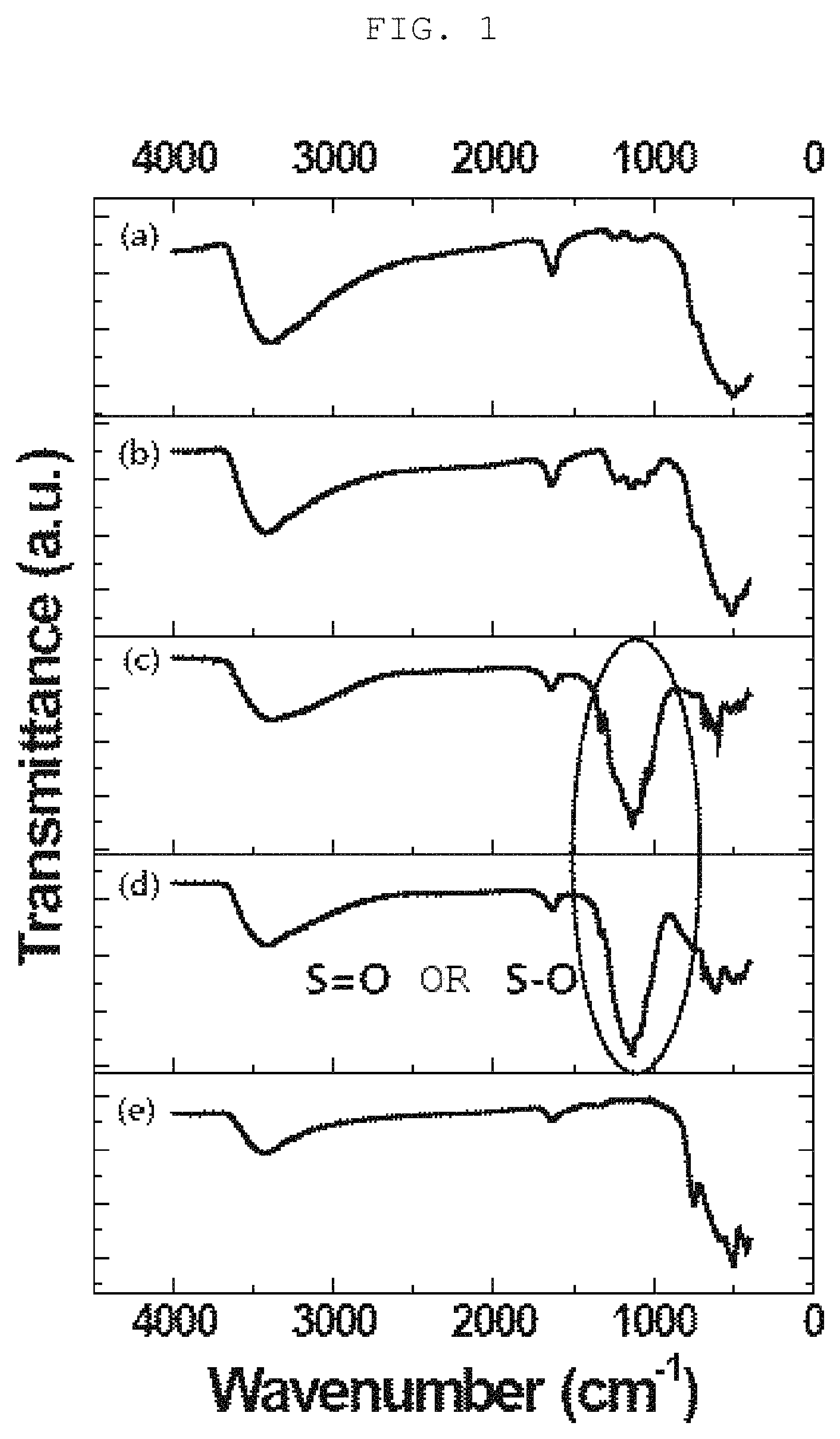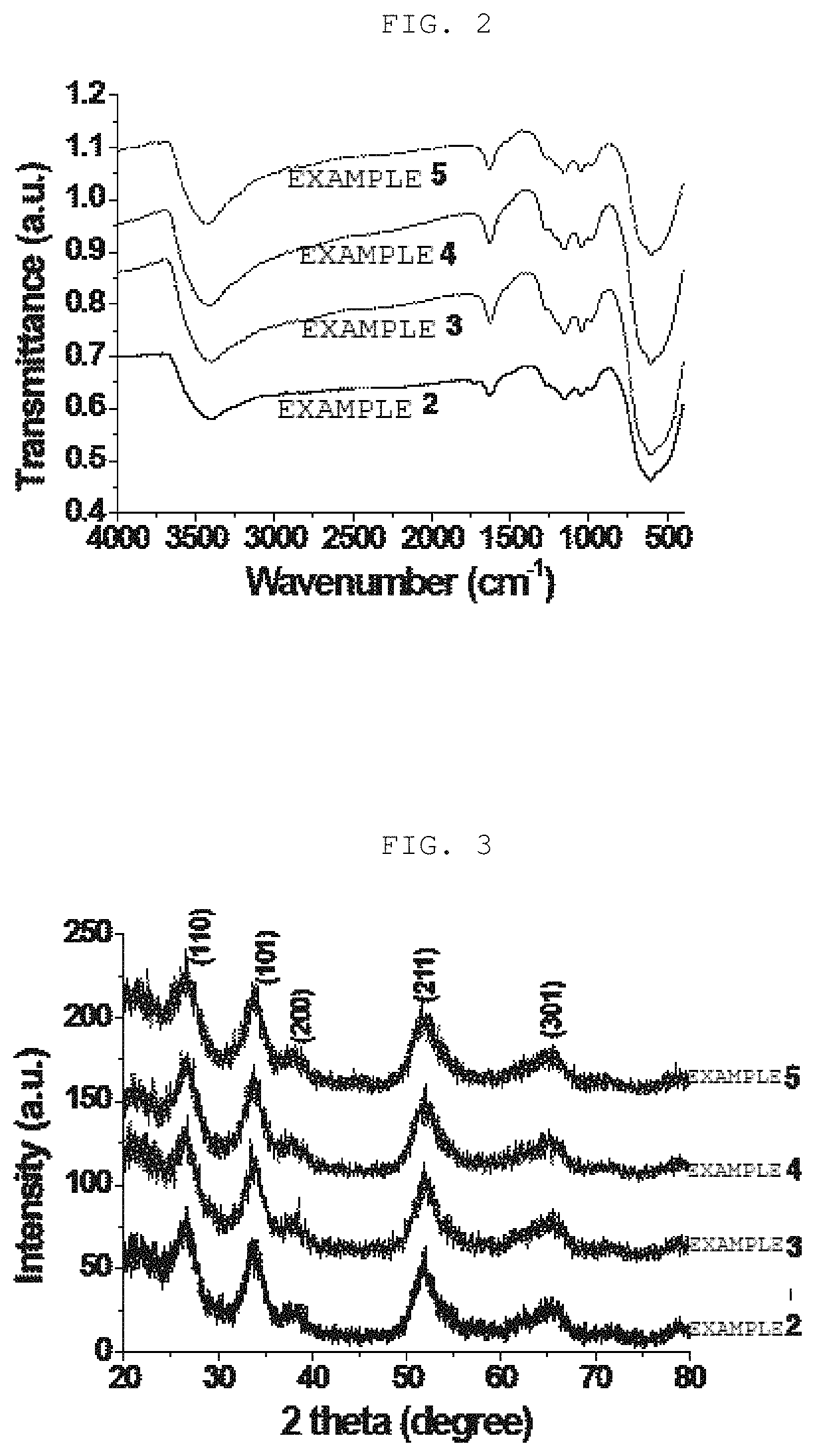Method for preparing sulfated metal oxide catalyst for chlorination, and chlorination method using sulfated metal oxide catalyst
a technology of sulfated metal oxide and chlorination method, which is applied in the direction of metal/metal-oxide/metal-hydroxide catalyst, physical/chemical process catalyst, calcination, etc., can solve the problems of poor methane conversion and selectivity to methyl chloride, and the research on an olefin synthetic process using methyl chloride has not received much attention, etc., to achieve excellent selectivity, increase the effect of methane conversion
- Summary
- Abstract
- Description
- Claims
- Application Information
AI Technical Summary
Benefits of technology
Problems solved by technology
Method used
Image
Examples
example 1
Preparation of Sulfated Zirconia Catalyst for Chlorination by Method of the Present Invention
[0092]2 g of glycine (Aldrich) and 12.32 g of ZrO(NO3)2.xH2O (Aldrich) were mixed at a molar ratio of 1:2, and then the mixture was dissolved in distilled water at a ratio of 2 ml mixture per gram of distilled water, thereby forming an aqueous solution. The formed aqueous solution was stirred at 80° C. for 2 hours, thereby forming a gel-type product having a high viscosity. The gel-type product was placed in an electric furnace, and then calcined at 350° C. for 3 hours, thereby forming zirconia (ZrO2) powder. An FT-IR spectrum of the formed zirconia powder corresponds to FIG. 1-(e). It is analyzed that a characteristic peak in a range of 460 to 850 cm−1 shows the presence of a Zr—O—Zr bond. The formed zirconia powder was impregnated with a 1 M chlorosulfonic acid / ethylene dichloride solution at a ratio of 15 ml zirconia powder per gram of 1 M chlorosulfonic acid / ethylene dichloride solution,...
experimental example 1
[0100]A chlorination reaction was performed by reacting methane with chlorine gas by using the sulfated zirconia catalysts prepared by Comparative Example 1 and Example 1.
[0101]The chlorination reaction was performed in a fixed bed reactor (length of 450 mm, inner diameter of 11 mm, Inconel tube reactor), and the reaction conditions were adopted as follows: (i) a temperature of 300° C.; (ii) a molar ratio of methane to chlorine gas of 2 / 1; and (iii) a gas hourly space velocity (GHSV) of each of methane and chlorine gas of 500 cc / g / h. A chlorine gas path in the reactor was shielded, and products produced by the chlorination reaction were analyzed by using gas chromatography (GC) using a HP PLOT-Q capillary column and a flame ionization detector (GC-FID). A methane conversion and a selectivity to products (chlorinated products of methane) are shown in [Table 3].
[0102]
TABLE 3CH4 / Cl2ReactionMethaneReaction(MolarGHSVtemperatureconversionSelectivity to product(%)catalystratio)(cc / g / h)(° C...
example 2
Preparation of Sulfated Tin Oxide Catalyst for Chlorination by Method of the Present Invention
[0110]25 g of tin chloride pentahydrate (SnCl4.5H2O) was dissolved in 500 ml distilled water, and then hydrolysis of SnCl4.5H2O was induced by adding aqueous ammonia (28%) until a pH of a solution reached 8 while stirring the solution at room temperature. At this time, a solid product was obtained by filtering a precipitate obtained by the hydrolysis, the obtained solid product was sufficiently washed with distilled water, and then the washed product was placed in a drying oven and dried at 110° C. for 12 hours or longer, thereby producing 5.5 g of tin hydroxide (Sn(OH)4). The produced tin hydroxide (Sn(OH)4) was impregnated with a sulfuric acid solution (concentration of sulfuric acid: 0.5 M) at a ratio of 15 ml tin hydroxide per gram of sulfuric acid solution, the solution was stirred for 1 hour, and then filtering was performed, thereby obtaining a solid product. The obtained solid produ...
PUM
| Property | Measurement | Unit |
|---|---|---|
| BET specific surface area | aaaaa | aaaaa |
| temperature | aaaaa | aaaaa |
| temperature | aaaaa | aaaaa |
Abstract
Description
Claims
Application Information
 Login to View More
Login to View More - R&D
- Intellectual Property
- Life Sciences
- Materials
- Tech Scout
- Unparalleled Data Quality
- Higher Quality Content
- 60% Fewer Hallucinations
Browse by: Latest US Patents, China's latest patents, Technical Efficacy Thesaurus, Application Domain, Technology Topic, Popular Technical Reports.
© 2025 PatSnap. All rights reserved.Legal|Privacy policy|Modern Slavery Act Transparency Statement|Sitemap|About US| Contact US: help@patsnap.com



